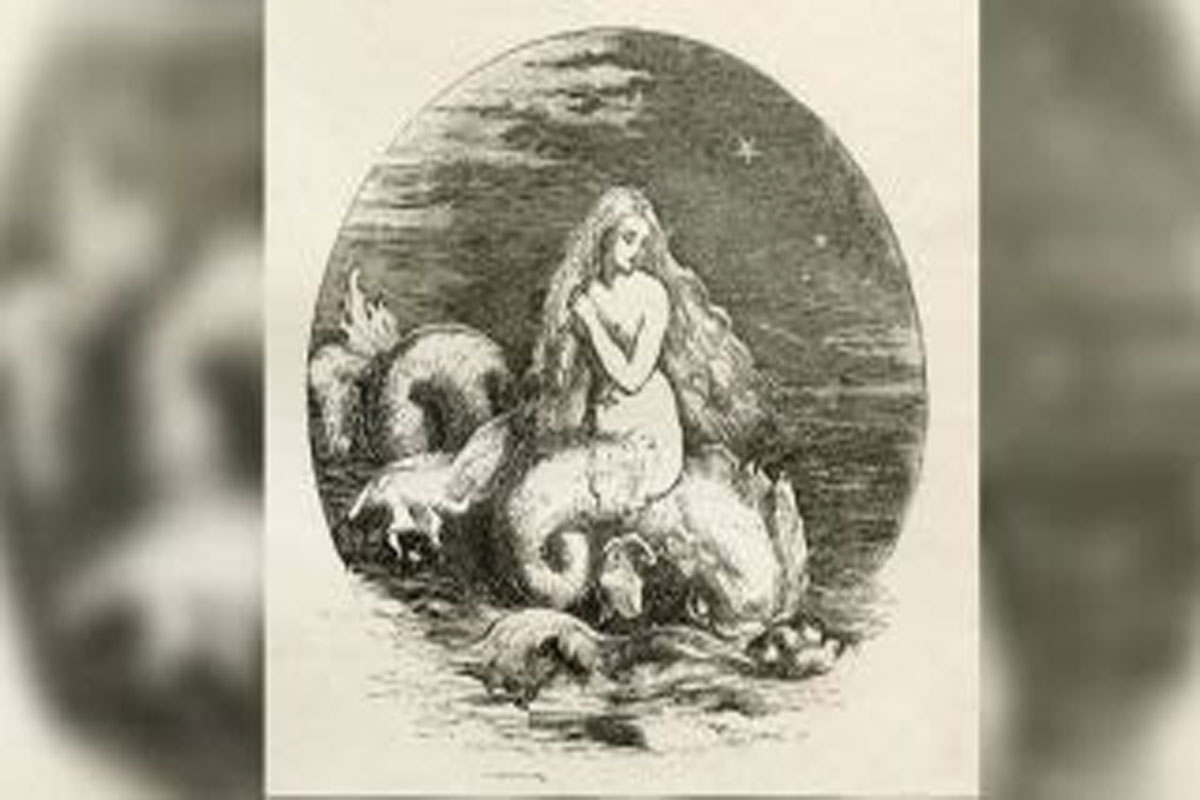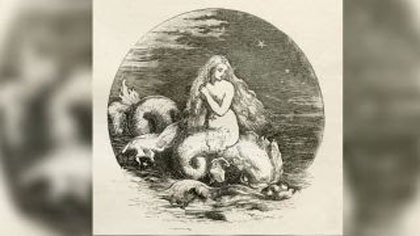
Mermaids & mermen: Facts & legends
By Benjamin Radford , Scott Dutfield
The mythological history of mermaids and their real-world origins
 An illustration of the mermaid Nix
An illustration of the mermaid Nix
Centuries ago, mysterious sea serpents and mermaids were believed to be hidden in the world’s vast oceans. Merfolk (mermaids and mermen) are, of course, the marine version of half-human, half-animal legends that have captured human imagination for ages. One source, the “Arabian Nights,” described mermaids as having “moon faces and hair like a woman’s but their hands and feet were in their bellies and they had tails like fishes,” Charles J.S Thompson, a former curator at the Royal College of Surgeons of England, notes in his in his book “The Mystery and Lore of Monsters (Kessinger Publishing, 2010). Thompson writes that “traditions concerning creatures half-human and half-fish in form have existed for thousands of years, and the Babylonian deity Era or Oannes, the Fish-god … is usually depicted as having a bearded head with a crown and a body like a man, but from the waist downwards he has the shape of a fish.”
Greek mythology contains stories of the god Triton, the merman messenger of the sea, and several modern religions including Hinduism and Candomble (an Afro-Brazilian belief) worship mermaid goddesses to this day. One of the earliest depictions of a mermaid came from Syrian mythology. Atargatis, also known as Derceto or the Syrian goddess, was half woman half fish deity of the ancient city Hierapolis-Bambyce in Syria.
An illustration of Derceto
An illustration of Derceto from the work of German scholar Athanasius Kircher, “Oedipus Aegyptiacus”, published in 1652. (Image credit: Athanasius Kircher/Public Domain)
However, many people are perhaps most familiar with the Disney version of “The Little Mermaid,” a somewhat sanitized version of a Hans Christian Andersen fairy tale first published in 1837. In some legends from Scotland and Wales mermaids befriended — and even married — humans. Meri Lao, in her book “Seduction and the Secret Power of Women,” notes that “In the Shetland Islands, mermaids are stunningly beautiful women who live under the sea; their hybrid appearance is temporary, the effect being achieved by donning the skin of a fish. They must be very careful not to lose this while wandering about on land, because without it they would be unable to return to their underwater realm.”
In folklore, mermaids were often associated with misfortune and death, luring errant sailors off course and even onto rocky shoals, according to the Ohio State University.
Though not as well known as their female counterparts, mermen have an equally fierce reputation for summoning storms, sinking ships and drowning sailors. One especially feared group, the Blue Men of the Minch, are said to dwell in the Outer Hebrides off the coast of Scotland, according to The Scotsman. They look like ordinary men (from the waist up anyway) with the exception of their blue-tinted skin and gray beards. Local lore claims that before laying siege to a ship, the Blue Men often challenge its captain to a rhyming contest; if the captain is quick enough of wit and agile enough of tongue he can best the Blue Men and save his sailors from a watery grave.
Related Links
Japanese legends have a version of merfolk called kappa. Said to reside in Japanese lakes, coasts and rivers, these child-size water spirits appear more animal than human, with simian faces and tortoise shells on their backs, according to Encyclopaedia Britannica. Like the Blue Men, the kappa sometimes interact with humans and challenge them to games of skill in which the penalty for losing is death. Kappa are said to have an appetite for children and those foolish enough to swim alone in remote places — but they especially prize fresh cucumbers.
Throughout West, South and Central Africa, the mythical water spirit called Mami Wata, which means “Mother of the Waters”, was once worshipped for their ability to bestow beauty, health and wisdom to their followers, according to the Royal Museums Greenwich. Mami Wata is often portrayed as a mermaid or snake charmer, however, her appearance has been influenced by presentations of other indigenous African water spriest as well as European mermaids and Hindu gods and goddesses, according to the Smithsonian.
Relief sculpture of Mami Wata
A relief sculpture depicting goddess Mami Wata on the wall of a voodoo temple in Adjokan, Benin. (Image credit: Getty Images)
‘Real’ mermaids?
The reality of mermaids was assumed during mediaeval times, when they were depicted matter-of-factly alongside known aquatic animals such as whales. Hundreds of years ago sailors and residents in coastal towns around the world told of encountering the sea maidens. One story dating back to the 1600s claimed that a mermaid had entered Holland through a dike, and was injured in the process. She was taken to a nearby lake and soon nursed back to health. She eventually became a productive citizen, learning to speak Dutch, perform household chores, and eventually converted to Catholicism, according to The Flying Dutchman and Other Folktales from the Netherlands by Theo Meder.
CLOSE
Another mermaid encounter once offered as a true story is described in Edward Snow’s “Incredible Mysteries and Legends of the Sea.” A sea captain off the coast of Newfoundland described his 1614 encounter: “Captain John Smith [of Jamestown fame] saw a mermaid ‘swimming about with all possible grace.’ He pictured her as having large eyes, a finely shaped nose that was ‘somewhat short, and well-formed ears’ that were rather too long. Smith goes on to say that ‘her long green hair imparted to her an original character that was by no means unattractive.'” In fact Smith was so taken with this lovely woman that he began “to experience the first effects of love” as he gazed at her before his sudden (and surely profoundly disappointing) realization that she was a fish from the waist down. Surrealist painter Rene Magritte depicted a sort of reverse mermaid in his 1949 painting “The Collective Invention.”
By the 1800s, hoaxers churned out faked mermaids by the dozen to satisfy the public’s interest in the creatures. The great showman P.T. Barnum displayed the “Feejee Mermaid” in the 1840s and it became one of his most popular attractions. Those paying 50 cents hoping to see a long-limbed, fish-tailed beauty comb her hair were surely disappointed; instead they saw a grotesque fake corpse a few feet long. It had the torso, head and limbs of a monkey and the bottom part of a fish. To modern eyes it was an obvious fake, but it fooled and intrigued many at the time.
The concept of aquatic humans was taken more seriously in 1960 when British Biologist Sir Alister Hardy proposed a new theory to explain some of the anomalies of human evolution. Our lack of fur, big brains and subcutaneous fat (qualities seen in marine mammals) are just some traits that lead Hardy to propose that humans descended not from Savannah dwelling apes, but more marine environments. Hardy and supporters of his aquatic ape theory suggest that humans took to the water to find food instead of land and eventually evolved to live in the water, which many have used to perpetuate the idea of mermaid existence, according to Ohio State University. Hardy’s theory remains largely controversial and lacking in evidence. The majority of archaeological evidence supports a human evolution that occurred on land rather than in the water.
Possible explanations for sightings
Could there be a scientific basis for the mermaid stories? Some researchers believe that sightings of human-size ocean animals such as manatees and dugongs might have inspired merfolk legends. These animals have a flat, mermaid-like tail and two flippers that resemble stubby arms. They don’t look exactly like a typical mermaid or merman, of course, but many sightings were from quite a distance away, and being mostly submerged in water and waves only parts of their bodies were visible. Identifying animals in water is inherently problematic, since eyewitnesses by definition are only seeing a small part of the creature. When you add in the factor of low light at sunset and the distances involved, positively identifying even a known creature can be very difficult. A glimpse of a head, arm, or tail just before it dives under the waves might have spawned some mermaid reports.
A manatee swimming
Manatee’s are thought to be mistaken for mermaids. (Image credit: Getty Images)
Modern mermaid reports are very rare, but they do occur; for example, news reports in 2009 claimed that a mermaid had sighted off the coast of Israel in the town of Kiryat Yam. It (or she) performed a few tricks for onlookers just before sunset, then disappearing for the night. One of the first people to see the mermaid, Shlomo Cohen, said, “I was with friends when suddenly we saw a woman laying on the sand in a weird way. At first I thought she was just another sunbather, but when we approached she jumped into the water and disappeared. We were all in shock because we saw she had a tail.” The town’s tourism board was delighted with their newfound fame and offered a $1 million reward for the first person to photograph the creature. Unfortunately the reports vanished almost as quickly as they surfaced, and no one ever claimed the reward.
In 2012 an Animal Planet special, “Mermaids: The Body Found,” renewed interest in mermaids. It presented the story of scientists finding proof of real mermaids in the oceans. It was fiction but presented in a fake-documentary format that seemed realistic. The show was so convincing that the National Oceanic and Atmospheric Administration received enough inquiries following the TV special that they issued a statement officially denying the existence of mermaids.
A temple in Fukuoka, Japan, is said to house the remains of a mermaid that washed ashore in 1222, according to the Smithsonian. Its bones were preserved at the behest of a priest who believed the creature had come from the legendary palace of a dragon god at the bottom of the ocean. For nearly 800 years the bones have been displayed, and water used to soak the bones was said to prevent diseases. Only a few of the bones remain, and since they have not been scientifically tested, their true nature remains unknown.
Mermaids may be ancient, but they are still with us in many forms; their images can be found all around us in films, books, Disney movies, at Starbucks — and maybe even in the ocean waves if we look close enough.
Additional resources
For more on Mermaids and other mythical creatures, check out “Mermaids: The Myths, Legends, and Lore” by Skye Alexander. To discover the many marine species that may have been misidentified as mermaids, head to Ocean Today produced by NOAA.
Bibliography
Arthur Waugh, “ TheFolklore of the Merfolk”, Folklore, Volume 71, January 2012, https://doi.org/10.1080/0015587X.1960.9717221
Peter Goggin, “”Are Mermaids Real?”: Rhetorical discourses and the science of merfolk”, Shima, Volume 12, November 2018.
M.J.B Verhaegen, “The Aquatic Ape Theory: Evidence and a possible scenario”, Medical Hypotheses, Volume 16m January 1985, https://doi.org/10.1016/0306-9877(85)90036-2
Scott is a staff writer for How It Works magazine and has previously written for other science and knowledge outlets, including BBC Wildlife magazine, World of Animals magazine, Space.com and All About History magazine. Scott has a masters in science and environmental journalism and a bachelor’s degree in conservation biology degree from the University of Lincoln in the U.K. During his academic and professional career,




















